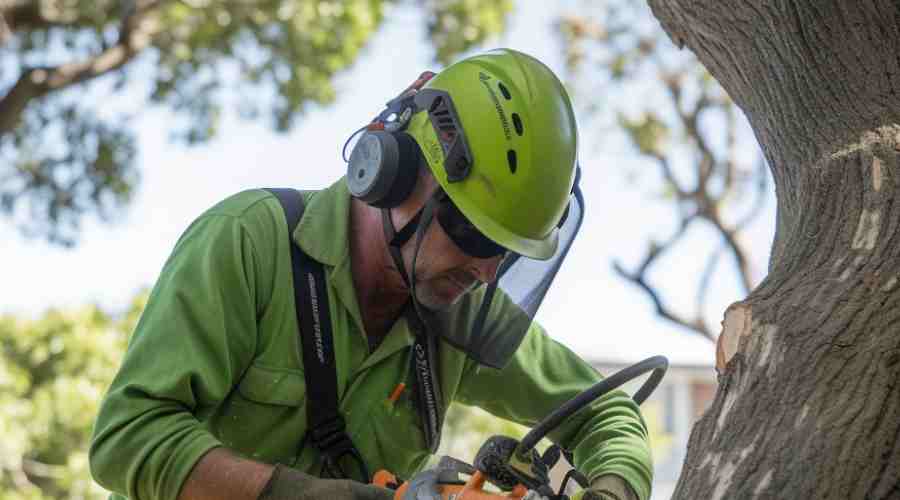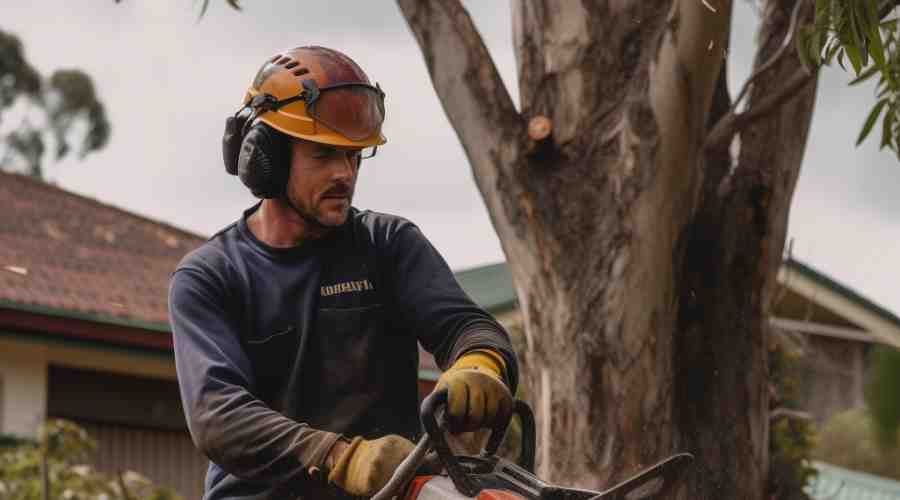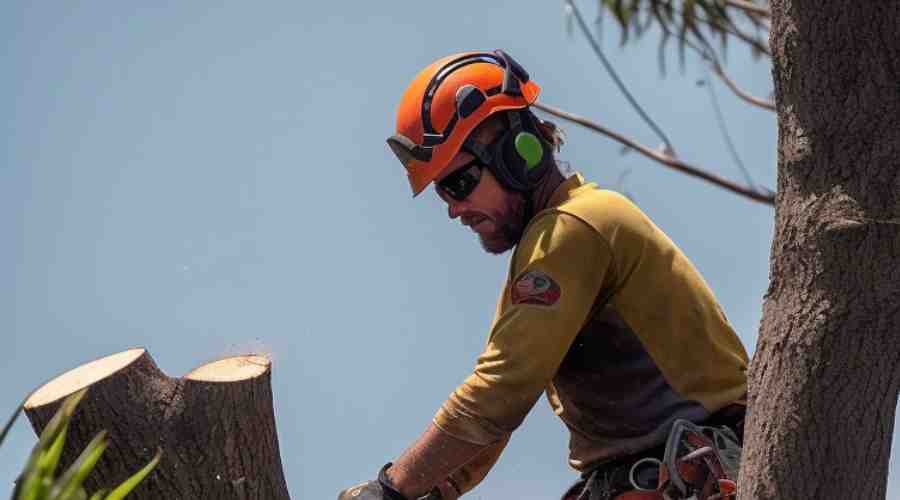Tree Removal Safety Guide
Staying Safe When Removing Trees
Removing trees, especially large trees, can be very dangerous if proper safety precautions are not taken. From falling branches to chainsaw injuries, many hazards exist for both homeowners and professional tree removal services. Following basic tree removal safety tips can help prevent accidents and injuries.
1. Wear Protective Equipment
Wearing the right safety gear is crucial when removing trees. Essential tools includes:
- Hard Hat – Protects your head from falling debris and branches. Look for hard hats meeting ANSI Z89.1 standards.
- Safety Glasses/Goggles – Prevents sawdust, dirt and debris from injuring eyes. Use impact resistant glasses with side eye protection.
- Hearing Protection – saws and wood chippers produce loud noise that can permanently damage hearing. Use earmuff style protection.
- Hand Protection – Sturdy leather gloves provide grip and guard against blisters, cuts and abrasions.
- Steel-toe Boots – Sturdy, non-slip boots with steel toes guard feet from crushing injuries if heavy logs shift.
- Leg Protection – Chaps provide an extra shield if a saw skids off course. Sturdy pants help prevent leg injuries from debris and brush.
Wearing personal safety equipment from head to toe is vital for remaining safe throughout the entire tree removal process.
2. Secure the Work Area
Before starting to cut, create a secure work zone around the tree targeted for removal. This keeps bystanders, children and pets away from danger.
- Place safety cones and warning signs around work area
- Use caution tape to block off zone
- Make sure no vehicles are parked nearby
- Have an assistant help ensure no one enters space
Constant vigilance of the area is key. Once cutting begins, wood chunks, falling branches and others can strike with force, and saws are unpredictable.
3. Use Proper Equipment
Specialised stuff for tree removal helps get the job done more efficiently while also promoting safety:
- Chainsaw – A gas-powered saw with sharp chain allows cleanly cutting through branches and trunks. Use one sized for the job.
- Wedges and Sledge Hammer – These drive wedges to fell trees in the desired direction.
- Ropes/Rigging – Helps safely lower cut sections to the ground.
- Chipper – Quickly processes brush into mulch to clean up debris.
- Truck – Hauls tools and removes waste wood.
- First Aid Kit – Contains essentials to treat any minor injuries.
Well-maintained equipment operated properly prevents many accidents. Know your limitations; some project should only be undertaken by licensed professionals with specialised tree removal and safety knowledge.
4. Assess and Address All Risk Factors
Before starting a tree takedown, survey the tree and area to pinpoint potential hazards you must manage:
Tree Assessment
- What direction is tree leaning? Determine likely fall path.
- Are there decayed or cracked/damaged areas? Compromised wood can break unpredictably when cut.
- Note branch structure and shape. Dead wood higher up can drop while cutting lower portions.
- Check for loose bark, vines, nails, and other foreign objects that can affect cutting.
Work Area Risk Assessment
- Are there people, vehicles, buildings, overhead power lines or other structures in area? Your safety zone must provide adequate buffer from these.
- Is terrain sloped or uneven? This can cause slipping while working.
- Where is access road so equipment can enter/exit unimpeded?
Identifying trouble spots allows planning proper precautions like setting out a wide safety zone, using gear to direct felled tree away from structures, and coordinating extra help.
5. Proper Cutting Sequence and Technique
Misusing cutting techniques causes many mishaps. Follow a planned cutting order and methodical approach:
1. Clear Area and Prepare Rigging/Ropes – Remove brush and visualise planned cuts before starting saw. Prepare anchor points and safety ropes to lower large pieces in controlled manner.
2. Trunk/Limb Cuts – Main cuts to remove bulk of tree trunk should be notch cuts whenever possible. This is safer than straight felling cuts.
- Notch cut involves two angled cuts opposite sides of the trunk which meet to create a V shaped “notch”. This notch helps guide the falling direction.
- After V notch established, make a felling cut horizontally across uncut portion of trunk to fell tree or limb.
3. Bucking and Sectioning – Once large sections are on the ground, bucking is cutting logs and dead branches into movable sections for transporting. Make flat bucking cuts across small limbs/logs to create rounds. Use a log stand to securely buck larger trunks.
4. Chip Debris – Use chipper to process debris after cutting work done. Feed with care, not hands.
Following a methodical cutting order reduces chances of wood shifting, pinching blades, or falling unpredictably.
6. Maintain Control and Awareness
Vigilance and care is mandatory when operating dangerous power apparatus. Power saw kickback or wandering torque are ever-present threats.
- Maintain solid, balanced stance – Especially on slopes; bend knees and brace legs
- Grip chain saw firmly with both hands and thumb wrapped around handles
- Keep saw close to body when cutting – Arm should be fully extended
- Be slow and deliberate with cuts – No jerky or aggressive movements
- Pay attention to positioning of body parts – Legs/feet clear of potential kickback or slip paths
- Stay alert to activity overhead – Falling limbs remain possibility
- Take breaks to maintain mental focus and avoid fatigue
- Stop work completely during electrical storms or high winds
Losing focus for even a moment can lead to severe accidents. Staying unhurried and purposeful with every saw action reduces likelihood of mishaps.
7. Get Assistance When Needed
Some tree removal scenarios call for getting help to boost safety:
- Large Trees – Tall or bulky trees often weigh tons. Have crew lower sections in controlled manner with rigging instead of free falling cuts.
- Leaning/ Poorly Positioned Trees – Unstable trees require using rope to slowly guide toward desired fall zone.
- Limited Visibility – Tight spaces, brush and poor light hamper hazard awareness. Extra ground spotters can warn you.
- Inexperienced Workers – Weekend warriors tackling tricky tree removal face added common risk. Professional assistance teaches proper methods.
Knowing limitations and calling qualified tree services to handle difficult, dangerous tree removal prevents compounding risk by proceeding alone.
8. Leave Job Site Clean and Safe
Finish the task fully by picking up any trash, covering holes or stumps, posting warnings if needed, and hauling away all wood and other waste . Scan area for any remaining tripping/falling hazards. A clean site restores the location’s safety for people using it afterwards.
With tree removal done properly using safety procedures, you gain useful firewood and lumber or clear space for landscaping while avoiding turned ankles, falling tree damage, or injuries. Prioritising safety truly impacts the outcome when removing trees. Weigh safety risks carefully beforehand. When in doubt, consult professional tree services to assist with safely finishing the job.
Tree Removal Safety Tips
| Safety Tip | Why It Matters |
|---|---|
| Wear proper tools- hardhat, glasses, gloves, chaps, boots | Guard against impact from falling objects and pinch/cut protection during cutting |
| Set up secured work zone/safety perimeter | Keep uninvolved people, vehicles away from workplace hazards |
| Use appropriate equipment – saws, ropes, chipper, truck | Correct tools handled properly prevent many accidents |
| Identify and address risk factors – lean, terrain, structures nearby | Planning allows establishing safety zones to minimise threats |
| Follow safe cutting technique and order | Methodical sequence from top branches down retains control, avoids unpredictable shifts |
| Maintain focus and controlled body positioning | Helps avoid slips or kickback injuries |
| Get assistance with large, tricky trees | Experts with proper rigging can safely guide difficult removals |
| Leave area clean when finished | Removes remaining tripping dangers |
| Know your physical limits | Fatigue leads to unsafe errors |
| Stop completely in severe weather | Lightning, high winds amplify threats of removing trees |
Conclusion
Removing trees safely prevents injuries and damage. When trimming smaller trees yourself, be very careful. Use climbing ropes, protective gear, cut carefully, and clean up after. Get help for big, tricky trees. Professionals have the right equipment and know-how to remove trees from the nearby power lines or buildings safely.
Before starting, think about what could go wrong. If it seems too dangerous or you don’t know what you’re doing, don’t use a chain saw. Many accidents happen because people are careless or in a rush. Tree removal can easily turn tragic. Safety comes first, so leave risky removals to the experts. They remove trees while keeping people and property protected. Don’t take needless chances with saws or tall trees. Assess carefully and call professional arborists when needed. Safety matters most in getting trees removed neatly without endangering, health, lives or homes.



